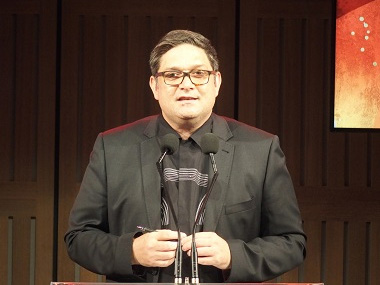DO WE WANT AN INDIGENOUS ARTS AUTHORITY?

Wesley Enoch, Chair of the Australia Council’s Aboriginal and Torres Strait Islander Arts Strategy Panel, who is proposing an Indignous Arts Authority
Jeremy Eccles | 31.10.18
Author: Jeremy Eccles
News source: Press Release
In a process not unlike the one that lead to the hugely consultative Uluru Statement from the Heart, a year of consultation is about to start towards establishing a National Indigenous Arts & Cultural Authority (NIACA).
For more than a decade, Indigenous arts facilitators have been arguing for a national body to promote and protect Aboriginal and Torres Strait Islander arts and culture. Tomorrow the first of many forums around the country will start to hear the views of ATSI people in Port Augusta on the subject. Like the Uluru process, it's only open to First Nations peoples. As the NIACA website explains: “Consultation forums are open to Aboriginal and Torres Strait Islander peoples. The online survey and submissions in response to the discussion paper are open to all people and organisations with an interest in the Indigenous arts and cultural sector”. That survey originally closed on 7th December, but has now been extended to 28th February.
Very much behind the whole process is Wesley Enoch, Chair of the Australia Council’s Aboriginal and Torres Strait Islander Arts Strategy Panel, also Director of the Sydney Festival. He's quoted as saying: “For artists, in particular, there are a lot of conversations around employment development through art, international and national markets of art, but not much conversation around the cultural worth and storytelling of that art and how we can have more of a conversation around these things,” which is a very good point. Clearly, only Indigenous cultural elders and artists can have such discussions.
The process has taken a long time to come to this stage, but Enoch insists it had to be done in a ‘cultural way’. He has spent considerable time canvassing artists, cultural workers and others to see if there is hunger for a body such as NIACA, and says there is an overwhelming one. “People say it is absolutely needed,’ he says. The forums continue into next year – and then a national gathering on First Nations arts and culture will be organised for the second half of 2019.
But some things are already clear. The goal is for NIACA to be a completely independent body, with the Australia Council acting as an interim secretariat to support the consultation process. Enoch intends NIACA to become a high-profile body, avoiding partisan politics in order to be able to advocate for changes and to consider key issues like intellectual property, moral rights, artistic rights in a digital age, and how technology engages with and enhances a cultural experience rather than replacing it.
“The focus must be on the long-term, inter-generational policies that we need to create systemic change,’ Enoch insisted. “Indigenous cultures work on multi-generations, not three-year cycles.”
Questions of funding the structure aren't mentioned yet. But one has to ask whether the Australia Council is funding the consultation forums? And what the Council's ATSI Strategy Panel will do if NIACA comes into existence? (Unrelated fact: there are no members of that Strategy Panel resident in the NT where so much art and culture come from! Odd?)
And one wonders just what NIACA will add to the current activities of the Indigenous Art Code and the National Association for the Visual Arts (NAVA), which has a dedicated Indigenous board member – currently artist Amala Groom? Challengingly, the online survey offers as its first question: “Do you think that a national body for First Nations arts and culture should exist?”
Of course, one wishes them better luck than the Uluru Statement has so far enjoyed!
URL: https://niaca.com.au/wp-content/uploads/2018/09/NIACA-Discussion-Paper_2018.pdf
Share this:
»  del.icio.us
»
del.icio.us
»  Digg it
»
Digg it
»  reddit
»
reddit
»  Google
»
Google
»  StumbleUpon
»
StumbleUpon
»  Technorati
»
Technorati
»  Facebook
Facebook
Contact Details
Further Research
News Archive
- 11.12.18 | DUBBOO
- 04.12.18 | Remote Arts Workers at UniMelb
- 29.11.18 | KATHLEEN PETYARRE
- 25.11.18 | NONGGIRRNGA
- 19.11.18 | Two Iconic Art Galleries for the NT?
- 17.11.18 | Passing Clouds
- 13.11.18 | The Uluru Statement comes to Sydney
- 05.11.18 | Skye's the Limit
- 31.10.18 | DO WE WANT AN INDIGENOUS ARTS AUTHORITY?
- 29.10.18 | MAJOR INDIGENOUS COMMISSION FOR THE ASIAN STAGE
- 17.10.18 | Tommy Watson in Sydney
- 10.10.18 | The Aboriginal Memorial – A Smouldering Reproach
- 03.10.18 | Closing the Craft Circle
- 25.09.18 | OCEANS APART
- 13.09.18 | SYDNEY CONTEMPORARY 2018
Advertising

